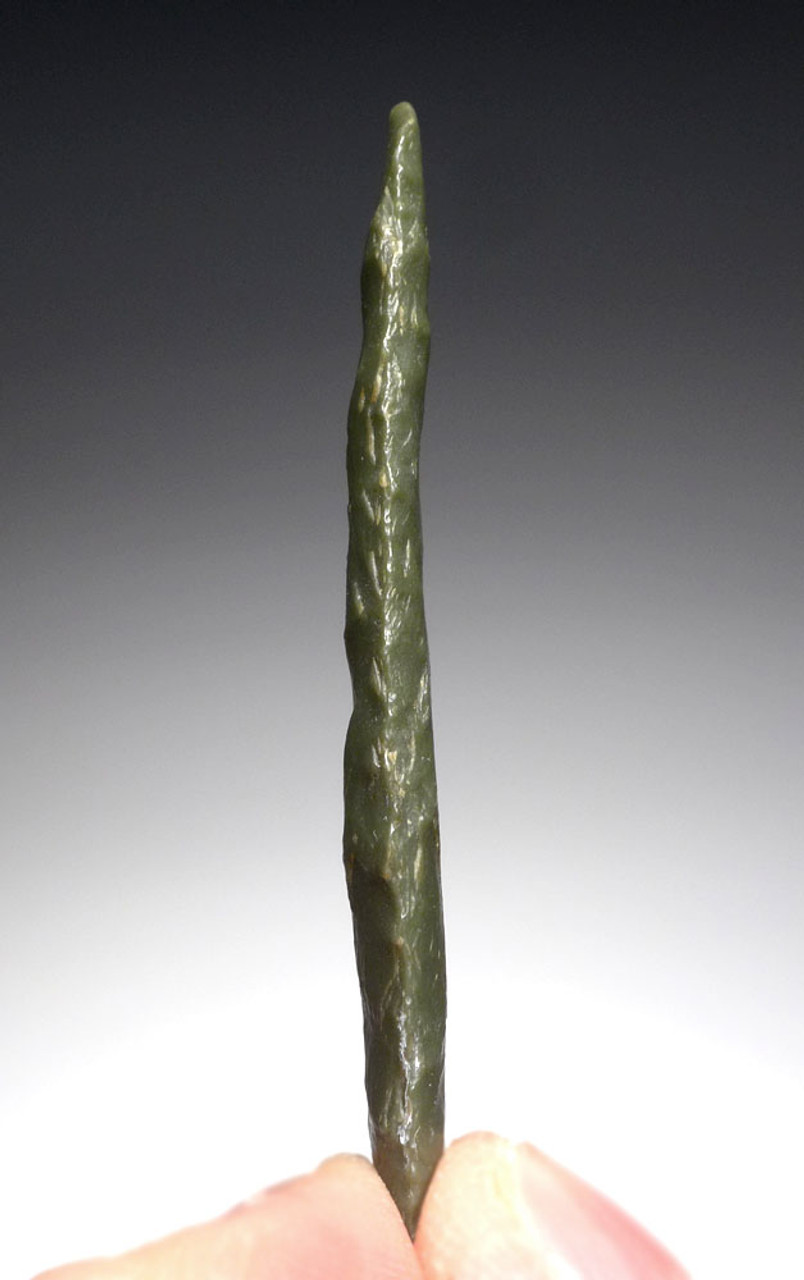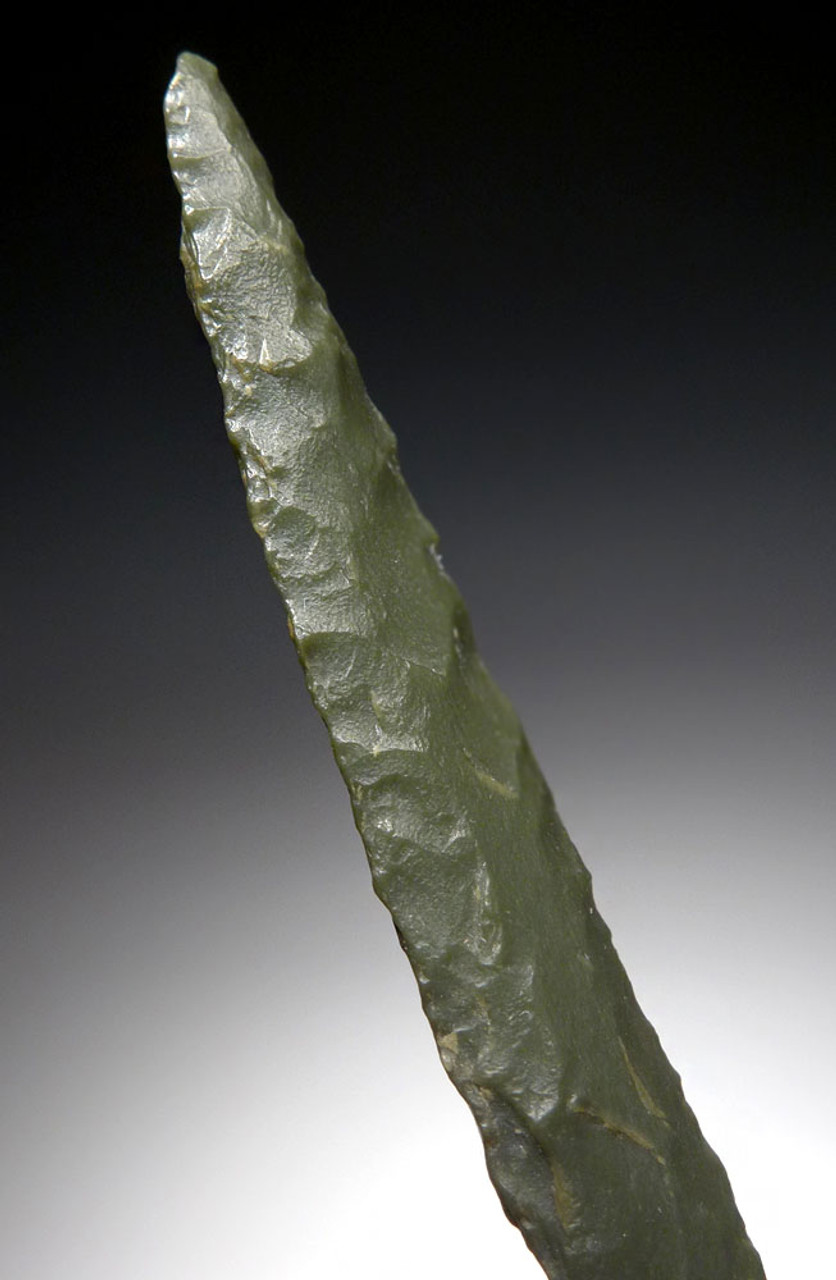Product Description
SEE MORE AFRICAN NEOLITHIC TOOLS AND ARTIFACTS
To truly emphasize the rarity of this offering, we must preface the description by disclosing that in all our international travel and seeing many amazing European collections, this is one of only two complete and intact Tenerian green jasper projectile points we have acquired in the course of 23 years.
This GEM bifacial projectile point comes from the Tenerian Neolithic of the South Central Sahara Desert. Most definitely made as a display of prestige, this arrowhead was made in the most prized lithic unique to these peoples and region - green jasper. Furthermore, it was made to such a high level of workmanship that far exceeds what an ordinary use arrowhead would have required. The extreme thinness, the perfect symmetry and the expert flaking indicates this was crafted by a master artisan of this Neolithic age. Fine details such as the slightly flared barbs and hollow base add to its overall uniqueness and beauty. One side even shows retained cortex of a lighter gold hue. To even find such a small object as this, is a truly rare event in of itself! Even the Sereno expedition hardly turned up projectile points such as this amazing specimen!
While arrowheads from the African Capsian Neolithic culture of the Northwestern Sahara are common, arrowheads from the Tenerian Culture are extremely rare. In browsing internet offerings from a variety of sellers, we see an extraordinary amount of mislabeled specimens claiming to be Tenerian when their lithic and style is unmistakably North African Capsian. Aside from scarce examples in lithics such as jasper or flint, the vast majority of true Tenerian projectile points are made of quartzite. Because of this, they seem crudely worked but keep in mind the sheer difficulty in shaping quartzite on such a small scale. It's virtually impossible to flake small objects such as arrowheads when you are working with quartzite so the crude shapes of Tenerian arrowheads are not a factor of poor skill but rather, a factor of the stone used.
On a dinosaur fossil-hunting expedition in 2000 by a team of scientific explorers led by Paul Sereno, a paleodune and ancient lakebed site was discovered that yielded over 200 ancient burials of Kiffian and Tenerian people. The scientific findings showed that this area was once a humid lake region that was home to a hunter-fisher-gatherer people. The area became known as the "Green Sahara" for its once fertile and habitable landscape. Noted paleontologist, Dr. Paul Sereno, famous for other Saharan dinosaur discoveries, shot into the archaeological spotlight with his discovery of the ancient lakebed cemetery at Gobero in Niger in the year 2000. Interred in the many burials were numerous stone tools, ceramics, shells, beads and bone harpoons typical for the lifestyle of these ancient people of the Green Sahara. This exceptional AUTHENTIC artifact is similar to the specimens found at Gobero. It comes from the same period and Tenerian Neolithic Culture of that famous discovery.
It is important to note that originally, Capsian Neolithic deposits could fill dozens of 5 gallon buckets whereas, Tenerian deposits of arrowheads are extremely scarce. Projectile points were never found in rich deposits like the Capsian Neolithic, making Tenerian projectile points immeasurably more rare!
We are very fortunate to have acquired an old French collection of these artifacts, years ago. Nevertheless, we have a very limited amount and once sold, we most certainly will never be able to replace them. Objects from the Tenerian African Neolithic culture are so rare that not even most major museums have a single object in their collection.
HISTORY
The Earth has been warming and cooling for millions of year, well long before humans were on the planet. One of the most dramatic examples of climatic change in the last 10,000 years is the desiccation of what is now the Sahara desert. Prior to as recent as 3000 B.C., the South Central Sahara region in Africa was a humid lake savanna. It was home to a thriving culture of ancient humans known as the Tenerians and before them, the Kiffians. The occupation of this area by these two peoples occurred continuously from around 7700 B.C. to the drying of the Sahara in 2500 B.C..
In the final Pleistocene and early Holocene Periods around 10,000 years ago, the South Central Sahara Desert was once a highly favorable environment for hunters, gatherers and pastoralists. Freshwater lakes existed between the dunes in what is now the Tenere region, Lake Chad was eight times its current size, the highlands supported Mediterranean forest trees, and a diverse variety of both large and small fauna flourished there. The slow drying out process of the Sahara, began 7,000 years ago and ended 4500 years ago resulting in the barren conditions that exist to this day. As we progress through time from the end of the Pleistocene towards the end of the Neolithic Period there, we see humans relying more on meat from raised animals as opposed to hunted animals that once roamed wild in the formerly Green Sahara.
 US DOLLAR
US DOLLAR
 EURO
EURO
 AUSTRALIAN DOLLAR
AUSTRALIAN DOLLAR
 CANADIAN DOLLAR
CANADIAN DOLLAR
 POUND STERLING
POUND STERLING


















